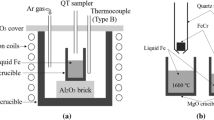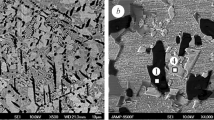Abstract
Two intermetallic layers Fe2Al5 and Fe2Al7 occur at the interface between the iron-chromium alloys containing 10 and 25 mass% Cr and the saturated aluminium melt at 700°C. Under conditions of simultaneous dissolution in pure liquid aluminium only the Fe2Al5 phase forms an adherent continuous layer, while the Fe2Al7, FeAl3, FeAl6, CrAl7 and other phases exist as inclusions in the aluminium matrix. Dissolution of the Fe—Cr alloy base into pure aluminium causes a three-fold decrease in layer thickness compared with the case where no dissolution occurs. A simple equation for evaluating the Fe2Al5 layer thickness during dissolution is proposed. Making the Fe—Cr alloy-to-aluminium transition joints, with the mechanical strength of the joint greater than or equal to that for pure aluminium (70–80 MPa), appears to be feasible.
Similar content being viewed by others
References
K. Barmak and V. I. Dybkov J. Mater. Sci. 38 (2003) 3249.
V. I. Dybkov ibid. 35 (2000) 1729.
V. I. Dybkov, “Reaction Diffusion and Solid State Chemical Kinetics” (The IPMS Publications, Kyiv, 2002) Chap. 5.
L. I. Mirkin, “Spravochnik po rentgenostrukturnomu analizu polikristallov” (Fizmatgiz, Moskwa, 1961) p. 458 (in Russian).
S. S. Gorelik, L. N. Rastorguev and Yu. A. Skakov, “Rentgenograficheskiy i elektronno-opticheskiy analiz: prilozheniya” (Metallurgiya, Moskwa, 1970) p. 33 (in Russian).
M. Hansen, “Constitution of Binary Alloys” (McGraw-Hill, New York, 1958) pp. 81, 90.
A. E. Vol, “Structura i svoystva binarnikh metallicheskikh system” (Fizmatgiz, Moskwa, 1959) Vol. I, pp. 217, 504 (in Russian).
T. B. Massalski, J. L. Murray, L. H. Bennett and H. Baker (eds.), in “Binary Alloy Phase Diagrams” (American Society for Metals, Metals Park, OH, 1986) Vol. I, pp. 103, 111.
L. F. Mondolfo, “Aluminium Alloys: Structure and Properties” (Butterworths, London-Boston, 1976) pp. 38, 68, 235.
G. Ghosh, in “Ternary Alloys: A Comprehensive Compendium of Evaluated Constitutional Data and Phase Diagrams,” edited by G. Petzow and G. Effenberg (VCH, Weinheim, 1991) Vol. 4, pp. 324–343.
J. L. Murray J. Phase Equil. 19 (1998) 368.
F. Van Der Woude and P. J. Schurer Canad. J. Phys. 65 (1987) 1301.
K. P. Gurov, B. A. Kartashkin and Yu. E. Ugaste, “Vzaimnaya diffuziya v mnogofaznykh metallicheskikh sistemakh” (Nauka, Moskwa, 1981) Chap. 6.
V. N. Yeremenko, Ya. V. Natanzon and V. I. Dybkov J. Mater. Sci. 16 (1981) 1748.
Author information
Authors and Affiliations
Rights and permissions
About this article
Cite this article
Barmak, K., Dybkov, V.I. Interaction of iron-chromium alloys containing 10 and 25 mass% chromium with liquid aluminium Part II Formation of intermetallic compounds . Journal of Materials Science 39, 4219–4230 (2004). https://doi.org/10.1023/B:JMSC.0000033402.37206.27
Issue Date:
DOI: https://doi.org/10.1023/B:JMSC.0000033402.37206.27




